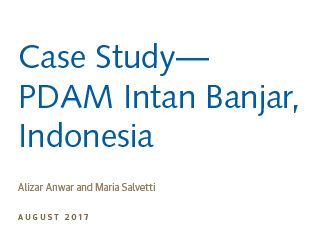Toolkit on the Aggregation Utilities. Toolkit case study in PDAM Intan Banjar, Indonesia
Water provision in the Banjar Regency started in 1982, and in 1988 the water utility (PDAM) Intan Banjar was set up as a public company. Because of rapid urban population growth, the municipality of Banjarbaru was created in 1999 within the territory of Banjar Regncy. Because Banjarbaru is a new city, its administration is entitled to establish institutions to provide local public services to its citizens. With respect to water supply, the city administration, however, decided to continue getting the water service from PDAM Intan Banjar, thus maintaining the water system and the operating area of the utility unchanged. Such a decision was taken to avoid diseconomies of scale. It was followed, a few years later, by a joint agreement between Banjar Regency, Banjarbaru Municipality, and South Kalimantan Province to fund important investments that would act as a Big Push, allowing the service to improve coverage and performance. A Water Sector Undergoing Important Reforms in the 1990s Before 1997, the provision of drinking water in Indonesia was a public duty supervised by the municipalities, whereas the central government’s main role was to establish a standard water sector policy and prepare technical assistance for the sector development. Because of economic turmoil in 1997, the government of Indonesia began to place a stronger emphasis on water, recognizing it as both a crucial economic good and a social good for society. As a result, the Indonesian water sector experienced major changes following important institutional, economic, and political reforms that enabled private sector participation in the 1990s. In 2004, a regulation regarding water resources was enacted to promote integrated and sustainable water management and to decentralize further responsibilities from the national level to the provincial governments. Further regulations opened the possibility for the development of water provision through private sector participation, associations, or self-provision. A regulatory body was also established to promote good-quality service at a realistic price, to ensure a balance between consumers’ and providers’ interests, and to improve the efficiency of drinking water services. The Creation of a New Municipality within Banjar Regency Boundaries Banjar Regency, which was established in 1959, covers an area of 4,688 km2 and is populated by 506,204 inhabitants.1 It is part of the province of South Kalimantan, which is located in the territory of Borneo. Water provision in Banjar Regency started in 1982 through the Drinking Water Management Agency (BPAM),2 which was established when the central government initiated a water supply project for Banjar. Operation and maintenance costs were borne by the project until BPAM was able to collect self-sustaining revenues. When BPAM could cover its operation and maintenance costs, it was transferred to the local government, which turned it into a public company. That company—the Water Supply Enterprise of Banjar Regency (PDAM Intan Banjar)—was established in 1988.3 Because of the rapid growth of this urban area, a new municipality, Banjarbaru, was declared in 1999. It covers an area of 371 km2 and has a population of 199,627 inhabitants.4 The separation process between Banjar Regency and Banjarbaru Municipality created a new administrative boundary, thereby dividing the operating area into two administrative entities
